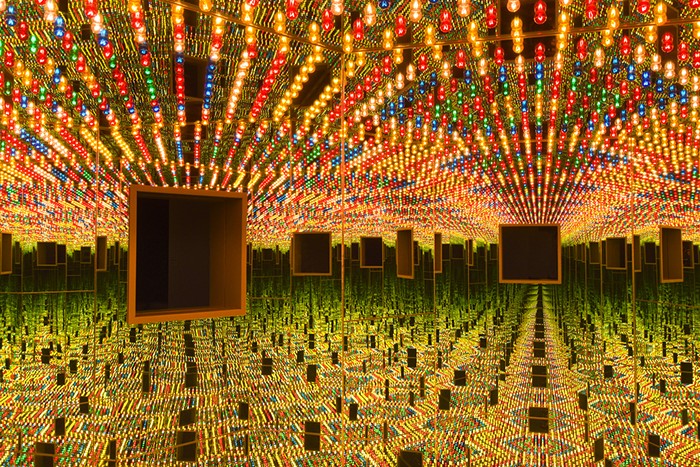In the summer of 2012, I had the opportunity to experience infinity. The exhibition was Yayoi Kusama's Fireflies on the Water at the Whitney Museum in New York. I reserved a ticket hours in advance, and at my scheduled time, there was a line several people deep. The anticipation heightens the experience.
I stepped through a white door and into small room with mirrored walls, two inches of water covering the floor, and a platform just large enough for one person. Electric lights dangled from the ceiling—150 to be exact—but their reflections in the mirrors extended in all directions to create a field of endless points of light.
I had one minute.
As my eyes adjusted to the relative darkness, I realized that I could begin to see reflections receding so far into the distance as to be barely perceptible, and moving my head a little bit revealed even more beyond those. The effect of the lights was so overwhelming that I felt tiny, despite being the only person in a room a little bigger than a supply closet. It was a completely immersive experience, like being in outer space, or in the inner depths of a meditative vision.
My minute was up.
Throughout history, many artists have grappled with the challenge of how to illustrate the concept of infinity given the limitations of both art materials and human perception. The mirror rooms that Yayoi Kusama began producing in the 1960s represent a breakthrough. Instead of trying to paint the idea of infinity, she had created a way for viewers to directly experience it.
Now a 50-year retrospective of Kusama's work, Infinity Mirrors, is coming to Seattle Art Museum, running June 30 to September 10. It includes Kusama's original mirror room, filled with red-spotted white phallic shapes.
Kusama was born in 1929 in Nagano Prefecture, Japan. Although she showed extraordinary interest and aptitude as a child, and had visual hallucinations that inspired her to draw what she had seen, her artistic aspirations were discouraged by her family.
"My mother told me that I was not allowed to paint, that one day I would have to marry someone from a rich family and become a housewife," she recalls in an interview produced by the Tate. "When I was a girl, she took away all my inks and canvases."
Instead, her mother would force her to spy on her father's illicit sexual exploits. The trauma from this experience instilled a lifelong disgust for sex, and a fear of the phallus in particular. According to Kusama, the phallic forms in many of her sculptures and installations were a form of art therapy. "I filled a room with them, and I lost my fear."
Determined to make an international name for herself as an artist, Kusama headed to the United States in 1957, originally settling in Seattle. Her first US exhibition was here, at the Zoe Dusanne Gallery—famous for bringing Northwest artists like Mark Tobey and Morris Graves to national attention. But Kusama's aspirations soon took her to New York, where she found an art scene dominated by white men.
Competitive and tenacious, she tried to outwork every one of them, producing a massive, highly inventive body of work, including "net" paintings depicting the negative space around thousands of tiny dots, and happenings that involved painting polka dots on hordes of naked bodies—another form of immersion therapy for her own sexual trauma.
Kusama established herself as a fixture of the avant-garde, but her success came at the price of long hours, short cash flow, and the constant grind of being a cultural outsider. In 1973, Kusama returned to Japan, where she eventually resumed her obsessive schedule. In 1977, after a particularly intense painting session, she checked herself into the Seiwa Hospital for the mentally ill in Tokyo. She has lived there ever since, voluntarily, checking herself out for nine hours a day to work in her studio nearby. It's a routine that lends stability and sustainability to a practice that can be, in the artist's own words, "self-obliterating."
Interest in Kusama's work has grown in recent years, due in part to high-profile exhibitions at the Tate, the Whitney, and other major international institutions. When Infinity Mirrors opened at the Hirshhorn Museum in Washington, DC, in February 2017, it drew more than 32,500 visitors in a week—the museum's greatest attendance for those dates in decades.
The show's next stop is Seattle Art Museum, and anticipation is already running high in the city that hosted her first US exhibition 60 years ago.
The playful accessibility of Kusama's work, paired with its genuine expression of cosmic wonder, has made her one of the most successful and iconic contemporary artists in the world. Infinity Mirrors promises to be a blockbuster exhibition for SAM and one of the must-see experiences of the summer.













